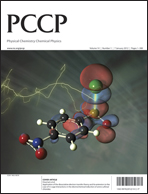研究脂肪酸基离子液体的性质:AMOEBA 力场的进展
IF 2.9
3区 化学
Q3 CHEMISTRY, PHYSICAL
引用次数: 0
摘要
为大分子开发多极可极化 AMOEBA 力场有其自身的复杂性。然而,通过将分子分割成更小的片段,并确保每个片段都能转移到其他系统中,可以在不影响精度的情况下简化脂肪酸等大分子的参数化过程。在本研究中,我们针对长链脂肪酸离子液体(LCFA-ILs)开发了基于片段的 AMOEBA FF。AMOEBA 使我们能够结合极化,从而显著提高这些大型高电荷系统的建模精度。这一点非常重要,因为离子液体的计算研究需要精确的建模。此外,要充分利用 IL 的可调性,必须测试大量阴阳离子组合,以确定最适合各种应用的配方。然而,进行此类实验需要大量资源和时间,但精确的分子建模可以加快探索过程。在此,我们将分解后的离子对分子间相互作用能量与量子力学计算确定的能量进行比较,以此作为参考,对新开发的参数进行了评估。通过在分子动力学模拟中采用这种 FF,我们预测了各种 LCFA-IL 的体积和结构特性,包括密度、汽化焓、扩散系数和径向分布函数。值得注意的是,实验数据与使用我们的参数计算出的数据之间的良好一致性验证了我们方法的准确性。因此,这一新程序为大型系统的参数化提供了准确的方法,为研究更复杂的系统(如脂类、聚合物、胶束和膜蛋白)铺平了道路。本文章由计算机程序翻译,如有差异,请以英文原文为准。
Investigating the Properties of Fatty Acid-based Ionic Liquids: Advancement in AMOEBA Force Field
Developing the multipolar-polarizable AMOEBA force field for large molecules presents its own set of complexities. However, by segmenting the molecules into smaller fragments and ensuring that each fragment is transferable to other systems, the process of parameterizing large molecules such as fatty acids can be simplified without compromising accuracy. In this study, we present a fragment-based AMOEBA FF development for long-chain fatty acid ionic liquids (LCFA-ILs). AMOEBA enables us to incorporate polarization to measurably enhance the precision in modeling these large highly charged systems. This is of significant importance since the computational investigation of ILs needs accurate modeling. Additionally, to leverage the tunability of ILs, it is essential to test numerous anion and cation combinations to identify the most suitable formulation for each application. However, conducting such experiments can be resource-intensive and time-consuming, but accurate molecular modeling can expedite the exploration process. Here, the newly developed parameters were evaluated by comparing the decomposed intermolecular interaction energies for ion pairs with energies determined by quantum mechanics calculations as a reference. By employing this FF in molecular dynamics simulations, we predicted bulk and structural properties including density, enthalpy of vaporization, diffusion coefficient, and radial distribution function of diverse LCFA-ILs. Notably, the good agreement between the experimental data and those calculated using our parameters validates the accuracy of our methodology. Therefore, this new procedure provides an accurate approach to parameterizing large systems, paving the way for studying more complicated systems such as lipids, polymers, micelles and membrane proteins.
求助全文
通过发布文献求助,成功后即可免费获取论文全文。
去求助
来源期刊

Physical Chemistry Chemical Physics
化学-物理:原子、分子和化学物理
CiteScore
5.50
自引率
9.10%
发文量
2675
审稿时长
2.0 months
期刊介绍:
Physical Chemistry Chemical Physics (PCCP) is an international journal co-owned by 19 physical chemistry and physics societies from around the world. This journal publishes original, cutting-edge research in physical chemistry, chemical physics and biophysical chemistry. To be suitable for publication in PCCP, articles must include significant innovation and/or insight into physical chemistry; this is the most important criterion that reviewers and Editors will judge against when evaluating submissions.
The journal has a broad scope and welcomes contributions spanning experiment, theory, computation and data science. Topical coverage includes spectroscopy, dynamics, kinetics, statistical mechanics, thermodynamics, electrochemistry, catalysis, surface science, quantum mechanics, quantum computing and machine learning. Interdisciplinary research areas such as polymers and soft matter, materials, nanoscience, energy, surfaces/interfaces, and biophysical chemistry are welcomed if they demonstrate significant innovation and/or insight into physical chemistry. Joined experimental/theoretical studies are particularly appreciated when complementary and based on up-to-date approaches.
 求助内容:
求助内容: 应助结果提醒方式:
应助结果提醒方式:


